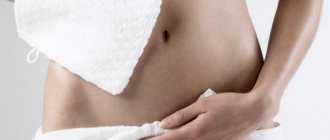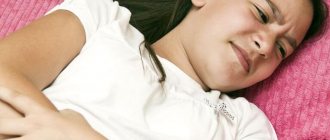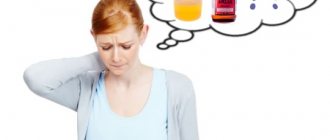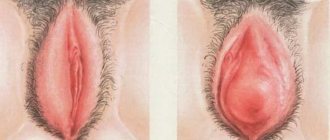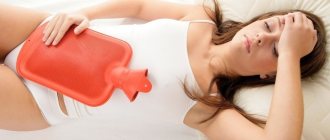A rash on the labia is a fairly common occurrence that occurs in women of all ages. In addition to affecting the labia minora and majora, rashes can be localized in the pubic area, as well as the vestibule of the vagina. The appearance of small pimples, blisters and pustules is often accompanied by itching, burning, pain of varying intensity or, on the contrary, does not cause any inconvenience.
There are many reasons that provoke such a pathology, but they do not always indicate the presence of some serious deviations in health. In some cases, a rash may occur as a result of individual physiological factors and may not require treatment. Conventionally, all genital rashes are usually divided into external and internal.
Allergies to the genital organs in women and men
In medicine, an allergy common to the genital organs of a man or woman is called “genital allergy.”
Depending on the nature of the lesion, it is divided into several types:
- lesion of the foreskin of the penis, which is irritating in nature - contact balanoposthitis;
- acute dermatitis, presented in the form of watery blisters - Lyell's syndrome;
- allergic reaction of an infectious nature - urethritis.
This phenomenon not only causes discomfort, it can also lead to the development of a viral or infectious disease or a weakening of the immune system. Therefore, if there is any change in the condition of the skin on the genital organ, you should immediately consult a doctor.
Prevention
It is possible to avoid inflammatory processes in the genital organs; you just need to be careful about hygiene procedures and do not neglect preventive examinations by a specialist. Boys should be observed as follows: until the age of 4-5 years, the head of the penis must be open, otherwise phimosis may develop and the baby should be urgently shown to a doctor.
Good quality underwear that fits, trousers that are not tight, gel for intimate hygiene and washing the genitals twice a day, as well as after each sexual intercourse, examination by a urologist once every 6-12 months - these are all the principles for the prevention of diseases of the penis in men.
Causes of allergies in adults
All causes of changes in skin condition are associated with internal or external penetration of the allergen.
There are several main reasons:
- Unprotected sexual intercourse , after which the woman develops red spots in the pubic area within 1–2 hours. Doctors call this syndrome vulvovaginitis. The main allergen is male semen released during sexual intercourse.
- Protected sexual intercourse. The condom is based on latex, to which an allergic reaction often occurs. In this case, both men and women may experience swelling or red spots on the skin of the genitals after sexual intercourse.
- Food allergies can occur on absolutely any part of the body.
- Taking potent medications aimed at preventing unwanted pregnancy and treating sexually transmitted diseases.
- The use of lubricants and other devices during sexual intercourse that improve sensations during this process.
- Using low-quality skin care products – soap, shower gel.
- Using low-quality underwear or washing clothes or bedding with the wrong detergent.
- Insect bites.
The cause of an allergic reaction is easy to identify, since it usually appears within a few hours after exposure to the allergen.
Symptoms and manifestations in women
First of all, allergies in women cause severe discomfort. Itching and burning appear in the affected area. In rare cases, a nagging pain appears.
In addition, the condition of the skin changes, and the following symptoms may appear on it:
- local redness of the skin;
- noticeable thickening (swelling);
- small red spots;
- watery pimples.
It is worth noting that an allergic reaction in women can easily be confused with the development of a pathological process. Therefore, it is not recommended to carry out treatment on your own.
It is imperative to consult a gynecologist or dermatologist.
Symptoms and manifestations in men
In men, allergies are also accompanied by not the most pleasant sensations:
- the appearance of a rash;
- redness;
- formation of watery pimples;
- swelling;
- peeling of the skin;
- the appearance of itching or burning.
The affected area is the head or base of the penis.
Non-infectious inflammation
Redness on the foreskin and glans is not always associated with infection. Such diseases are non-contagious - transmission does not occur either through sexual contact or in everyday life. They appear during hypothermia, local irritation of the skin and mucous membranes, as well as due to allergic reactions.
The clinical manifestations of non-infectious balanoposthitis are similar to the symptoms of sexually transmitted diseases, so it is important to get diagnosed and tested
Lichen planus
Lichen planus is a pathology of allergic origin, but its exact cause remains unclear. It appears as purple or white rashes around the head of the penis. They do not cause pain or discomfort, and the disease can be mistaken for candidiasis. Lichen planus should be distinguished from other forms of lichen, which are contagious diseases.
Eczema, psoriasis
Eczema is a complex disease that can develop for several reasons. It occurs as a result of allergic reactions, diseases of internal organs and endocrine glands, including diabetes mellitus, hypothyroidism, and pathologies of the stomach and intestines. Its manifestation can be triggered by non-compliance with hygiene rules and wearing tight underwear made of synthetic fabrics. A small rash appears on the skin of the penis, which then bursts and forms ulcers.
Psoriasis is a chronic pathology, during which periods of remission and relapses are observed. It also manifests itself in the genital area of men in the form of a small rash. At different stages of the disease, the rash will differ:
- stearin stain - painful redness, prone to peeling;
- terminal film - a transparent coating that appears when the scales are removed;
- Bloody dew is a sign of film damage.
The disease can spread to the groin and buttock areas. Patients complain of pain in the external genitalia and urethra. It increases with urination and ejaculation. The skin swells and may itch and sting.
Allergy
Allergies are another reason why genital irritation in men may occur. It is a pathological reaction of the human immune system to contact with any substances. Depending on the type of stimulus, several types are distinguished:
- contact - occurs directly at the point of contact with the allergen (including intimate hygiene products, some types of fabrics);
- medicinal - develops after taking certain medications.
Contact allergies go away on their own after eliminating the irritant. However, if a painful itchy rash has appeared on the skin or mucous membranes, it must be treated with external means.
Dermatitis as a symptom of systemic diseases
Many systemic diseases have a wide range of symptoms. They also manifest themselves as dermatitis on various parts of the body and on the genitals. Patients also complain of a general deterioration in health and additional symptoms characteristic of a particular disease.
Redness of the skin and mucous membranes can be observed with the following pathologies:
- diabetes mellitus;
- inflammatory and ulcerative lesions of the digestive tract;
- parasite infestations;
- disorders of the thyroid gland.
Dermatitis caused by systemic diseases is a sign of an allergic reaction of the body to helminth toxins or metabolic disorders. Toxic compounds are not excreted, but accumulate in tissues, which is manifested by itching and irritation.
One of the diseases that manifests itself with itching and rash on any part of the body, including the genitals, is atopic dermatitis. It is of autoimmune origin, that is, it is a pathological reaction of the immune system to its own organs and tissues. The process worsens under stress, against the background of infectious diseases and other factors.
Mechanical and chemical effects
Irritation on the head without itching may be a symptom of a mechanical or chemical effect on the skin or mucous membrane. There is always the possibility of chafing your penis during prolonged sex or getting irritated by aggressive detergents. A painful swelling appears on the skin, but a rash does not form. Dryness and redness may be observed in the area of the glans and frenulum of the genital organ, and the mucous membrane begins to crack. Another reason is diaper rash during the hot season when wearing underwear made of synthetic fabrics. They are accompanied by discomfort and aching pain, which intensifies with movement.
Diagnostics
Every adult should remember that allergies can be one of the symptoms of a serious disease, sexually transmitted or oncological.
Therefore, at the first signs of a change in the condition of the skin on the genital organ, you need to immediately go to the clinic for a diagnostic examination.
It usually includes several mandatory measures:
smear analysis to determine the nature of the microflora;
- blood test to determine the amount of immunoglobulin E;
- allergen detection tests;
- general blood analysis;
- general urine analysis.
During a laboratory study, the doctor will be able to determine whether an allergy is exactly what caused the appearance of such symptoms. And what exactly does such a reaction occur to?
Possible diseases
I would like to start with the fact that some rashes on the head in men without itching appear in adolescence and can be confused with harmless pathologies that do not require any treatment or removal:
- . A common phenomenon among men, occurring in 25-45% of cases. The peak occurs during puberty, when small grain-sized lesions appear around the head of the penis. They do not hurt, do not itch or bleed. Soft to the touch, slightly raised above the surface of the skin. The number of rashes can reach several dozen. With age, the size may increase, but rarely exceeds 2-3 mm. Localization - over the entire surface of the head and foreskin.
- Contact dermatitis. Oddly enough, but a very common phenomenon not only among teenagers, but also adult men aged 25-40 years. The reason is commonplace - an allergic reaction to synthetics (underwear and bed linen), detergents (soap, shower gel), personal hygiene products (loofah) and other substances. Very often, rashes on the head in the form of red spots appear from condoms or their lubricant. Also, the reason may lie in the use of various types of lubricants.
- . This is a fungal disease, which is characterized by a chronic, relapsing course. It is also called male thrush because it is caused by fungi of the genus Candida. The main symptom is the appearance of red rashes on the head of men, which can resolve spontaneously, which makes timely detection of the disease very difficult, since many are confident that they are completely healthy, since there are no visible disorders. Very often, thrush in men also manifests itself in the form of a sour odor and severe itching along the entire length of the penis. Less commonly, pain may occur during urination. It is transmitted sexually and can also be “intensified” after prolonged use of antibiotics.
- Fordyce granules. They look like white rashes on the head and along the entire length of the penis in men. They usually appear at the age of 13-20 years. Many people confuse them with white pimples of viral origin, but doctors assure that Fordyce granules are absolutely benign formations that are not transmitted from one person to another and do not pose a threat to health. Their appearance is not accompanied by any subjective sensations. When pressed, a whitish mass of thick consistency may be released.
- Gonorrhea. A very common sexually transmitted disease (in 95% of cases). But here the main symptoms are cutting pain during urination and purulent discharge from the urethra when pressed. Then red rashes appear on the head, usually around the urethra, and unbearable itching. The disease is dangerous for both sexes, as it can cause the development of secondary infections (in 35-60% of cases) and lead to infertility. Chronic forms can be asymptomatic, which leads to the fact that the patient, without knowing it, can infect other people for a long time.
- . Common formations of viral origin (genital warts are based on the human papillomavirus), which can be localized on the head, foreskin and along the entire length of the male penis. The quantity usually does not exceed 5-7 pieces. Size 3-5 mm, less often 10-15 mm. Distinctive features are flesh-colored or dark brown, a “warty” appearance and the absence of subjective sensations (provided that the formations are not localized near the urethra). Transmitted sexually.
- Urogenital chlamydia. Another common sexually transmitted disease, which is 10 times more common than gonorrhea and 7 times more common than syphilis. Almost always occurs simultaneously with other sexually transmitted infections (gonorrhea, gardnerella, trichomonas and ureaplasma). The main symptoms are gray and yellow purulent discharge from the urethra (usually in the morning), cutting pain during urination, cloudy urine and rashes on the head, accompanied by swelling and moderate itching. Chlamydia poses a serious danger to men and women, as it can cause serious complications, manifested in the form of erection problems, premature ejaculation and ultimately leading to infertility.
Separately, I would like to say about syphilis, which very rarely, but still, manifests itself in the form of pinpoint rashes on the head in men. Most often they are observed with primary and secondary syphilis and can be present on the skin and mucous membranes for 20-40 days.
Internal preparations
In case of severe discomfort, you cannot do without the use of drugs orally. They are divided into 2 categories: enterosorbents and antihistamines.
Enterosorbents
Preparations available in powder form. The active component penetrates the body and eliminates all “unnecessary” substances from it.
Adults can use two types of the drug:
- "Polysorb" . The dosage of the medication is calculated according to his body weight: 0.1–0.15 per kilogram of weight. For a person whose weight is more than 60 kilograms, 1 heaped tablespoon of powder diluted in 100–150 ml of water is enough. During the acute period of the disease, it can be taken 2-3 times a day. The general course of treatment for an allergic reaction should not exceed 14 days. As for contraindications, these include individual intolerance to the component and any disorders of the gastrointestinal tract. The cost of the medicine is about 400 rubles .
- "Polyphepan" . The composition of the body cleansing product includes plant components: fiber and lignin. Therefore, it is absolutely safe and is allowed even during pregnancy and breastfeeding. The approximate cost of the drug is 120 rubles .
- Activated carbon is the simplest remedy that removes harmful substances from the body, which is sold in pharmacies in a wider range without a doctor’s prescription. An adult needs to take 1 tablet per 10 kg of body weight, 2 times a day. It is not recommended to take it for more than 7 days in a row, as this can lead to leaching of beneficial substances from the body.
Polysorb Polyphepan Activated carbon
Antihistamines
Antihistamines contact the allergen and eliminate its effect on the human body.
The most effective among them are:
- "Zyrtec" . The daily dosage of the drug for adults is 10 g. It can be taken at one time or divided into two doses - 5 grams in the morning and evening. Contraindications to its use are pregnancy, breastfeeding, individual intolerance to one of the components included in the product. The estimated cost of Zirtek in tablet form ranges from 170 to 300 rubles .
- "Fenistil" . Available in the form of drops or a ball-on applicator for external use, which requires treating the affected area of the body. Adults can take 4-5 drops orally 3 times a day. Contraindications include 1 month of pregnancy. The cost of the drug is about 300 rubles .
The course of taking antihistamines should not last more than 10 days.
Zyrtec Fenistil
Topical preparations
For external use for allergies, non-hormonal and hormonal ointments are used. The first type is suitable for diseases with mild manifestations. Drugs containing hormones are prescribed to treat severely advanced allergies.
For women:
- Hormonal-based hydrocortisone ointment is ideal for treating the female genital organs , as it allows you to cope with the problem as quickly as possible. It needs to be applied in a thin layer to the area where there is a rash or redness. Contraindications include individual intolerance to the component. It is not recommended to take it yourself during pregnancy. The cost of the medicine ranges from 30 to 50 rubles .
For men:
- Only hormonal ointment can quickly eliminate rashes and itching on the penis. For example, this is Prednisolone ointment. A contraindication to its use is individual intolerance to the component. It is forbidden to use it if there are open wounds or sores on the genitals. The product must be applied 3 times a day to the affected area of the body. Its cost is about 50 rubles .
Hydrocortisone Prednisolone
Many allergy medications are sold in pharmacies without a doctor's prescription. Despite this, it is recommended to visit a specialist and undergo a diagnostic examination before using them.
Treatment
Treatment of rashes on the genital organs in women is prescribed only by a specialist based on the cause of their appearance. The main goal of therapy is aimed at eliminating the disease that provoked the allergic rash.
The causes and treatment of genital rash are carried out using second-generation antihistamines:
- Ebastine;
- Levocetirizine;
- Desloratadine;
- Claritin;
- Suprastin.
Additionally, the dermatologist may prescribe glucocorticoids, tranquilizers, calcineurin inhibitors, selective serotonin inhibitors, and muscarinic acetylcholine receptor blockers.
If it has been established that the provoking factor is syphilis, antibacterial therapy is required using long-acting drugs - these are Tetracycline, Erythromycin, Doxycycline. At the same time, not only the sick person is treated, but also all partners who had sexual contact with him during the illness.
For skin diseases of the genital organs of fungal origin, antimycotic tablets are used - Fluconazole, Miconazole, Gistan.
Hormonal agents in the form of ointments are also used:
- Advantan;
- Hydrocortisone;
- Beloderm.
Many people, faced with a disease such as genital eczema, are absolutely sure that washing their genitals several times a day will help correct the situation. This is far from true. Frequent hygiene procedures can only worsen the situation. Genital eczema is treated with topical medications, such as steroid ointments. Therapy is carried out only under the supervision of a doctor.
Treatment of psoriasis on the labia in women is carried out only under strict medical supervision. Therapy should be comprehensive - in most cases it includes the use of anti-inflammatory and antibacterial drugs.
For genital dermatitis, the doctor prescribes antihistamines and antifungal medications, as well as products for external application.
Allergies to the genitals in infants
The baby's body is not yet fully formed and protected from influencing factors, so it is more susceptible to the formation of an allergic reaction, including in the labia area.
Reasons for appearance
Causes of red spots or rashes include:
- Using a powder that has a coarse composition. It is recommended to use special children's household products.
- Wearing the same diaper for a long time, resulting in an allergic reaction or heat rash.
- Irregular adherence to hygiene rules.
- Using clothes made of low quality material.
- Use of low quality hygiene products.
- Penetration of parasites into the body.
- Treatment of the mother or child with potent drugs.
It is important to promptly establish the cause of the allergy in order to prevent its re-development.
Symptoms and manifestations
An allergic reaction to the genitals in infants manifests itself with similar symptoms as in adults.
It is worth highlighting a few of the most common ones:
- In its normal state, the skin on a baby’s genitals is soft and smooth. When an allergic reaction occurs, it becomes covered with small scales, which are quite easy to recognize both visually and to the touch.
- Another distinctive sign is the appearance of itching. The baby will constantly experience a feeling of discomfort, which will be signaled to the parent by his restless behavior.
- The most obvious signs of an allergy are redness or a rash on the skin.
It is worth noting that children under 1 year of age have many contraindications for taking medications. Therefore, it is strictly forbidden to self-medicate. Only an experienced specialist - a pediatric allergist or dermatologist - can select a set of the most suitable drugs.
Diagnosis in infants
A diagnostic examination of the skin of a baby is carried out strictly in stationary and laboratory conditions.
To do this, you need to do a number of actions:
Visit an allergist and tell him about the baby's concern. The specialist will first conduct a visual inspection.
- To obtain the most reliable information, your baby will need to undergo a smear from the urethra, a general urine and blood test.
- A special analysis - an immunogram - will allow you to identify what exactly the allergic reaction occurred to.
- In rare cases, if problems arise with making a diagnosis, it is necessary to study the medical history of not only the patient himself, but also his parents.
The purpose of a diagnostic study is to confirm or refute that changes in the skin are associated with an allergic reaction.
Topical preparations
Children are allowed only non-hormonal ointments and gels that have a gentle effect on the body. The main purpose of their use is to eliminate discomfort and relieve inflammation in the affected area of the body.
There are two effective ways to cope with this problem:
- Gel "Fenistil" is approved for children from the age of 1 month. It is required to apply a small amount of viscous consistency to the genital area. The cost of the drug ranges from 200 to 250 rubles .
- Elidel cream is the most effective remedy. But, its use is possible only when the child reaches the age of 3 months. The principle of application is simple - you need to apply a small amount of the substance to the affected area of the skin. The cost of the medicine ranges from 900 to 960 rubles .
Fenistil Elidel
Allergy in infants is not a rare phenomenon, but, fortunately, it can be eliminated quite easily.
Consultation with a doctor is required
If the cause of the development of itching and rash lies in the action of one or another microorganism, complex treatment is prescribed, consisting of taking an antihistamine and an antibiotic or antiviral agent.
Antihistamines (tavegil, suprastin) are used to relieve discomfort during therapy, since sometimes identifying the type of microorganism and its elimination take quite a long time. Antibacterial drugs are used both topically (for example, using clotrimazole cream to treat candidiasis) and orally or intramuscularly. For some diseases, douching of an antibiotic solution directly into the urethra is prescribed. Sometimes, when treating some other diseases not related to the reproductive system, if a rash occurs, including on the genitals, stopping the drug is enough to improve the condition.
In some cases, especially when condylomas develop on the surface of the penis, their surgical removal is required. If assistance is not provided, there is a significant risk of these condylomas degenerating into cancer (human papillomavirus infection is considered a precancerous disease). If you delay in providing help, in the most severe cases, amputation of the penis may be required. If surgical intervention is not advisable (old age or serious condition of the patient), you can limit yourself to courses of radiation and chemotherapy in parallel with taking antiviral drugs.
If the cause of the development of itching and rash is of an allergic nature, typical antiallergic therapy is prescribed - most often antihistamines, some infusion solutions, and vitamin complexes are used.
Each of them has its own role - antihistamines promote competitive binding to histamine receptors, preventing it from causing all allergic manifestations; the role of infusion solutions (sodium chloride, Ringer's solution, Trisol, Acesol) is to dilute the blood plasma and reduce the concentrations of circulating antigens; vitamin preparations are intended to normalize the immune system and the normal course of its reactions (since when an allergy develops, the immune response is usually excessively strong). Most often, several sessions of such treatment are enough to eliminate all existing symptoms.
The use of glucocorticoids for the treatment of these diseases is advisable only in the case of local application and their effect. When glucocorticoids are administered systemically, the benefits of their use are often much less than the consequences that may occur while taking them.
The use of physiotherapeutic methods has not particularly justified itself. More or less effective methods used to strengthen local immunity are UHF therapy and the use of a bioptron. These procedures contribute to the activation of local immunity and its correction in case of possible violations. Most often they are used during the rehabilitation period to quickly restore all body functions.
Allergies to the genital organs in girls and boys
Unfortunately, the number of children diagnosed with genital allergies is constantly increasing.
There are many reasons for its development, mainly due to the use of low-quality clothing or household products, as well as the penetration of an allergen or infectious virus into the body. Symptoms of the development of the disease in boys and girls are slightly different.
Symptoms and manifestations in girls
- the appearance of severe itching in the labia area;
- burning sensation in the vaginal area;
- formation of watery pimples;
- the appearance of swelling in the labia area.
Symptoms and manifestations in boys
- the appearance of severe itching around the base or on the genitals;
- rash formation;
- swelling of the glans penis;
- peeling of the skin.
If a boy or girl complains of discomfort in the genital area, then you should immediately consult a pediatrician or allergist about this problem.
Causes of the disease
Rashes on the genitals can have a variety of causes, both related to diseases and manifestations of allergic reactions. All factors that provoke the appearance of a rash in intimate places can be divided into two main groups - internal and external. Internal ones are associated with infection and diseases of various etiologies, external ones are associated with allergic reactions.
The main causes of rashes on the labia:
- Candidiasis STD – growths can be caused by a fungal infection or sexually transmitted diseases.
- Syphilis, a disease that develops over years, also causes a rash on the genitals.
- Genital psoriasis.
- Eczema of the genital organs.
- Atopic dermatitis.
- Genital herpes.
- Hormonal imbalance in the body.
- Oncological diseases.
Allergy to the labia in women is a fairly common occurrence. Girls' skin turns red and swollen for various reasons:
- male sperm;
- latex or condom lubricant;
- ointments and creams for intimate use;
- underwear made of synthetic materials;
- use of various personal hygiene products.
A common cause of this unpleasant phenomenon is genital dermatitis - this is an extremely common disease that can occur at any age. Genital dermatitis develops due to the use of a variety of cosmetic and hygiene products, household chemicals, and washing powders.
How to treat dermatitis on the labia - no special therapy is required, you just need to avoid the substance that causes the allergic reaction.
Eczema occurs quite often on the genitals. It can be identified by numerous red nodules, which are grouped into plaques with a dry, dense surface. Eczema in women on the genitals usually affects the area around the vagina.
Many parents are faced with the problem of allergies to the genital organs of their children.
It is most often observed in girls under 12 months of age. A newborn boy suffers much less often from allergic manifestations.
The main causes of allergies to the labia in a child:
- Children's clothing or underwear made of synthetic materials.
- Cosmetic and hygiene products can cause rashes on the pussy.
- Disturbances in the digestive system.
- Hives on the labia often appear after using diapers.
- Fungal infection in breast milk.
- The presence of highly allergenic foods on the baby’s menu.
Allergies to the labia in infants are treated with antihistamines - Zodak, Fenistil, Cetrin, Loratadine. For ointments and creams, Afloderm or Screen-Cap are used. Parents should remember that all medications have age restrictions and contraindications, so only a doctor should prescribe them.
Diagnostics
For children, as for other patients, a number of diagnostic studies are carried out to determine the nature of the disease and identify the cause of the development of allergies.
Diagnostics consists of several stages:
- An initial visit to the doctor, which involves a description of the complaint and a visual examination of the small patient.
- Complete blood count, additional blood test for immunoglobulin E.
- A swab from the top layer of skin.
- General urine analysis.
Diagnostics is a mandatory measure to reveal the full clinical picture of allergies.
Internal preparations
To treat an allergic reaction in the labia area, enterosorbents, prebiotics and probiotics, or antihistamines can be used. It is worth talking about each group of drugs in more detail.
Enterosorbents
Enterosorbents are prescribed to infants to prevent the effects of allergens on the body and generally improve the patient’s well-being.
There are two most popular drugs allowed for children from the first day of life:
- "Polyphepan" is available in the form of powder for suspensions, used only internally. Children under 1 year of age are allowed to take 5 grams of the drug 1 hour before meals. The powder should first be diluted with half a glass of boiled water. The procedure should be repeated 3 times a day for no more than 1 week. The cost of the drug ranges from 70 to 120 rubles , depending on its volume.
- “Smecta” is also available in powder form, which must be diluted in half a glass of boiled water before use. Children whose age does not exceed 1 year are prescribed one sachet per day, which must be divided into 2-3 doses. The general course of treatment is from 2 to 7 days. The cost of “Smecta” is approximately 120 to 170 rubles .
Polyphepan Smecta
Many mothers try to cure their child “the old fashioned way” with activated carbon. But, doing this is highly not recommended. This is due to the fact that the weight of an infant does not exceed 10 kilograms, therefore, 1 tablet of activated carbon already provokes the leaching of useful substances from the body.
Prebiotics and probiotics
Prebiotics and probiotics are absolutely safe, but at the same time, substances necessary for the human body. They restore the functioning of all organs after illness and saturate the little man with useful microelements.
- “Bifidumbacterin” is the most popular probiotic, approved from the very first day of life. This drug is available in powder form, placed in ampoules. Each of them contains 5 doses of the substance. To restore the body of a baby up to 6 months old, you will need to take 1-2 doses 3 times a day. The powder should first be diluted with warm water. It is recommended to take it with meals. The cost of the drug ranges from 100 to 250 rubles .
- "Hilak Forte" is available in the form of a colorless, transparent liquid. Children under 6 years of age are recommended to take 15–30 drops at a time; Children aged 6 years and older should take 20–40 drops. The cost directly depends on the volume of the bottle; it can range from 400 to 1000 rubles .
- "Rotabiotic Baby" is available in the form of sachets that need to be dissolved in boiled water. Children from 1 year to 3 years are recommended to take 1 sachet 2 times a day. The approximate cost of the medicine is 400 rubles .
Bifidumbacterin Hilak forte Rotabiotic
Antihistamines
Antihistamines are absolutely necessary for any occurrence of an allergic reaction. They can quickly relieve itching and discomfort, but do not neutralize the cause of the allergy.
There are two types of drugs that can be given to infants:
- Zodak is a drug that helps relieve allergy symptoms. Available in the form of a clear liquid placed in a bottle with a dispenser. A strict contraindication is age under 6 months. Older children - from six months to a year are allowed to take Zodak, but under the strict supervision of a specialist, they are also prescribed the dosage of the drug. Its cost ranges from 120 to 300 rubles .
- "Cetrin" allows you to quickly forget about all allergy symptoms. It is available in the form of tablets and drops. For children, it is preferable to use the second option. Babies aged 6 months to 1 year are prescribed 5 drops per day, which can be taken at once or divided into 2 doses. The cost of the product ranges from 130 to 250 rubles .
- "Suprastin" is the most effective antihistamine. It comes in the form of a clear, odorless solution. Prescribed by a doctor for itching, intended to eliminate allergies, regardless of the cause of its occurrence. Available in the form of ampoules. A strict contraindication is children under 1 year of age. Children from 1 to 5 years old are allowed to use 1 quarter of the contents of the ampoule. Children from 5 to 14 years old are allowed to take from half an ampoule to 1 whole ampoule.
Zodak Cetrin Suprastin
The baby's body is very susceptible to all medications entering his body. Therefore, it is recommended to take medications strictly as prescribed by a pediatric allergist or dermatologist.
List of effective drugs
Modern pharmacology offers a significant number of medications aimed at eliminating inflammatory processes in men. Depending on the severity of the symptoms, the attending physician prescribes the following medications:
- Anti-inflammatory drugs. These include antibacterial ointments, creams, and solutions. When applied correctly and regularly, they relieve inflammation.
- Painkillers. Burning, itching and irritation of the foreskin in men can be treated with painkillers.
- Regenerative drugs. They have a regenerating effect, thanks to which you can get rid of cracks on the penis.
- Antimicrobial and antifungal medications. These drugs suppress the activity of pathogenic microorganisms, that is, inflammation of an infectious nature.
Let's take a closer look at the most common and effective drugs that help relieve inflammation and pain during balanoposthitis.
Zinc ointment
This drug has antimicrobial and anti-inflammatory effects. Prescribed for the treatment of inflammation of the foreskin caused by infection. Regular use of Zinc ointment helps get rid of swelling, redness and irritation, and this medicine also has a drying effect.
Pimafucin
This is an antifungal ointment that is prescribed for balanoposthitis caused by the active development of pathogenic microorganisms. Pimafucin is one of the most gentle antifungal drugs on the modern pharmacological market, and therefore does not cause side effects.
Triderm
This is a combination drug that contains antimycotics, glucocorticosteroids and antibiotics. It is highly effective even in severe cases of balanoposthitis. Triderm helps eliminate the unpleasant symptoms that accompany the disease and also have a detrimental effect on the cause of its development.
Batrafen
One of the most effective antifungal drugs, but is highly effective only in the early stages of the inflammatory process. In such cases, Batrafen quickly relieves inflammation, thereby relieving symptoms such as itching, burning, and irritation on the penis.
Fluconazole
This medication is available in the form of tablets and ointments. Both types of Fluconazole have a pronounced antifungal effect. In a short time it relieves inflammatory processes, as well as unpleasant symptoms of balanoposthitis in the form of burning, itching, irritation, swelling. It also has a calming effect at the local level.
Dermozolon
This drug is prescribed for the treatment of erosive and simple balanoposthitis. Also helps fight fungal and viral infections. It has a healing, anti-inflammatory and anti-allergic effect when applied topically.
Levomekol
This product is available in the form of a gel for topical use. Relieves inflammatory processes caused by fungal and bacterial infections. Levomekol is an antibacterial drug, so the recovery process takes a short period of time. Has an antiseptic effect.
Clotrimazole
Helps fight inflammation of the glans and foreskin in men caused by the active activity of yeast fungi. Quickly relieves inflammatory processes, thereby eliminating unpleasant symptoms.
Miramistin
Available in various forms, but for the treatment of inflammation of the foreskin in men it is used as a solution. It is highly effective in the development of balanoposthitis against the background of certain sexually transmitted diseases.
The following topical medications also help fight inflammatory processes: Nizoral, Lokasalen, Synthomycin ointment, etc.
Important to remember! You can use medications for inflammation of the foreskin only after the appointment of your doctor!
Internal preparations for all patient groups
Preparations for internal use, as for patients of any age category, are divided into 3 main groups:
Enterosorbents
- "Polysorb" for children is available in the form of a powder, which must first be diluted in 100 ml of water. The dosage of the medication is calculated according to his body weight: 0.1–0.15 per kilogram of weight. During the acute period of the disease, it can be taken 2-3 times a day. The general course of treatment for an allergic reaction should not exceed 14 days. The cost of the medicine is about 100 rubles .
- Enterosgel is available in the form of a paste. To use it, it is recommended to dilute the recommended dosage with water, with the proviso that the volume of liquid will exceed the volume of the paste three times. Children under 5 years of age are recommended to take half a tablespoon 3 times a day, 1-2 before or after meals. The cost of the medicine ranges from 360 to 420 rubles .
Polysorb Enterosgel
Topical preparations
To achieve a positive effect, not only internal use of drugs is required, but external treatment is also required.
The best means for this purpose are drugs such as Screen-cap or Afloderm. The cream is intended for children over 3 years of age. The principle of their use is similar: you need to apply a thin layer of the product to the affected area of the body 2 times a day.
The cost of the “Screen-cap” drug ranges from 300 to 400 rubles .
The cost of the drug "Afloderm" for children is approximately 200–250 rubles .
Afloderm skin cap
Prevention of allergies on the labia
Allergy to the genital organs is not the most pleasant ailment, which can cause a number of complications. Therefore, it is better to prevent its occurrence.
To do this, you need to follow several preventive measures:
- It is recommended to adhere to proper nutrition , completely eliminating foods that contribute to allergies.
- Contact with infected people should be minimized . During periods of acute illness, you should stay at home if possible.
- It is recommended to use only good quality underwear , such as cotton fabric.
- Infants should not wear diapers for a long time.
- People prone to allergies need to use hypoallergenic products for body care and laundry.
- It is required to follow generally accepted hygiene procedures: take a shower and bath every day.
- Adult men and women should avoid having unprotected sex with a new partner.
Compliance with preventive measures does not guarantee that an allergic reaction will definitely be avoided. But, this will reduce the risk of its occurrence.
Symptoms
Allergies to the genital organs have different symptoms, depending on the cause. But there are a number of signs that are considered common and bother a person most often. Most common symptoms:
- itching and swelling;
- irritation;
- tissue redness;
- burning.
The rash on the labia in women or the penis in men looks like dense red bumps or papules filled with clear or purulent fluid. Under no circumstances should they be squeezed out, as this can lead to infection.
With candidiasis, rashes and itching of the labia are accompanied by copious whitish, curd-like discharge that has a sharp, sour odor. Also a common symptom is discomfort during sexual intercourse, burning and discomfort during urination.
Syphilis - manifests itself as red rashes on the labia with a smooth, shiny surface, looking like lumps or warts of various sizes. After some time, the nodules begin to dry out and crust over. May be accompanied by enlarged lymph nodes, no other signs.
Pubic psoriasis is one of the localizations of atypical psoriasis, a severe systemic disease. Genital psoriasis is considered its most dangerous and difficult to treat form. With psoriasis, red plaques with silvery scales, peeling, and redness appear on the genitals - they are accompanied by severe itching and burning. Most often they are localized in the pubic part and folds. When the plaque is scraped off, a spot with a bloody surface remains.
Genital herpes - a characteristic symptom of the disease is the appearance of small blisters with purulent or whitish-transparent contents. Such papules are very painful; they become swollen, red, inflamed and itchy. In some cases, the activation of the herpes virus is caused by taking any medications.
Hormonal imbalance also provokes various rashes in the groin and genital area in men and women. In most cases, they appear during hormonal changes - puberty, pregnancy or menopause. The seals are completely painless and do not cause any discomfort, being only a cosmetic drawback.
Oncological diseases are the most dangerous cause of changes in genital tissue. Bleeding ulcers, erosions and non-healing wounds appear on the skin, which gradually occupy large areas of the body.
